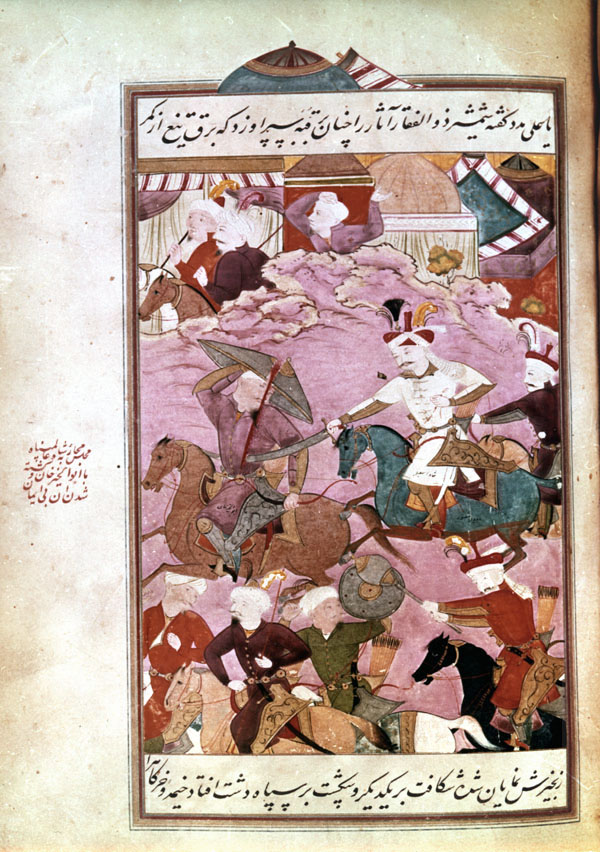Shah Esmāʿil Kills Abuʾl Ḵeyr Khan in Battle
The year is 919/1513; the place is somewhere in Khorasan, and the principal combatants are Shah Esmāʿil and the Uzbeg Abuʾl Ḵeyr Khan, son of Qāsem Khan (see folio 273v). Across the center of the painting, moving from right to left, Shah Esmāʿil is pursuing his adversary. As in previous paintings, the shah is dressed in a gold trimmed white knee-length coat, with a red and white flat top qezelbāš tāj on his head. His usually light gray horse is here shown with a bluish cast, but true to form its lower quarters are stained brownish-red. Esmāʿil leans slightly forward in the saddle, and with his right arm fully extended, thrusts a sword to cut his adversary in two vertically from head to waist. Abuʾl Ḵeyr Khan, dressed in purple astride a brown horse, and holding a bow in his left hand, has attempted to defend himself by holding a shield over his head. But it has been of no avail - the awesome power of the shah’s blow has split the shield as well as his body, and blood gushes forth. Behind the shah, on the far right, is a ḡāzi shooting arrows at some unseen assailant, while in the lower foreground another Safavid, dressed in vermillion and riding a black horse, swings a heavy mace in pursuit of three Uzbegs. The three, all wearing white turbans, seem more intent on fleeing than fighting. The last in the group raises a shield to ward off the blow of a mace swung by a ḡāzi. Customary with many of the other paintings, the event is depicted on a hillside simply rendered in a light mauve, which rises to a craggy rock formation near the top of the picture. Beyond the crest are the multi-colored tents of the Uzbeg encampment populated by three figures whose upper torsos only are visible. One gestures frustration, but the other two, on horseback, seem oblivious to the events occurring below.
Cf. manuscript L, folio 232, for another version of this painting, and for a summary of the event depicted. For a third variant see also Ms. N, JK_463. Although there are considerable differences between the three paintings, that they are mutually influenced is certain. This version seems to be the most refined and finished in the group, but not necessarily the most successful in all aspects. There are several elements of awkwardness - although Esmāʿil is behind Abuʾl Ḵeyr Khan, his sword penetrates him from the front; and the turban of the Uzbeg in the lower left is partially obscured by Abuʾl Ḵeyr Khan’s horse which is further back in the pictorial space - these spatial problems do not occur in the British Library variant that appears looser and more accomplished in draftsmanship.
Painting: 18.0 x 13.0 cm. Dimensions from Mahboubian catalog. A marginal inscription in red describes the event depicted. Inscriptions in black appear on two of the figures, identifying them as Abuʾl Ḵeyr Ḵān and Shah Esmāʿil, and also on Esmāʿil’s horse calling it the “mule of Manṣur”. The meaning of this phrase is not clear, but it also appears on a horse in the painting on folio 217.
Location: Reza Abbasi Museum, Tehran, No.77.1.7, folio 273v
Painting: 15.9 x 13.3 cm. Dimensions after Mahboubian catalog; A red marginal inscription describes the event. Inscriptions in black are written on two figures, identifying them as jāni beg solṭān and qāsem ḵān.
Painting references:
Mahboubian_1972, #923 folio 273v (not ill.).
Text references:
See Muntaẓer-Ṣāḥeb_1970, p.493 for this event in the History of Shah Esmāʿil.
Robert Eng
Last Updated: Dec. 20, 2011 | Previous update: Dec. 15, 2010 | Originally published: April 4, 2002
